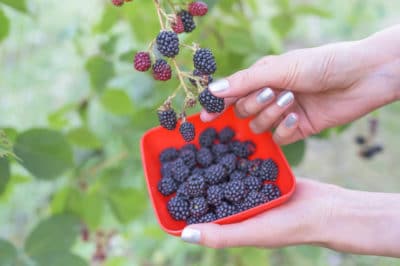Picking Season
Depending on variety, blackberries grow in USDA plant hardiness zones 4 through 9. The different climate conditions across those zones play a huge role in determining when they’re ripe enough to pick.
In the United States, early-season blackberries start ripening in early June, followed by mid-season varieties in July and August. Late-season primocane cultivars ripen from mid-September into October. Planting cultivars from each group rewards you with fresh blackberries from early summer through mid-fall.
Expert gardener’ tips:
- Nearly all blackberries bear their first crops in the second year after planting.
- Don’t let glossy-black grocery store berries fool you; they aren’t allowed to ripen completely before being picked. For maximum sweetness, let your blackberries ripen to dull black.
Harvesting Ripe Blackberries
Because they’re so fragile, ripe blackberries need to be harvested by hand. For the best results, do it when they’re dry during the coolest part of the day. Wet blackberries are susceptible to molding in storage.
Grasp a cane in one hand (wearing gloves if it has thorns) and lightly pull on the berry you want. If it resists, move on to the next one. Set the berries carefully in your collection containers. Don’t pack them in or you’ll crush the ones at the bottom. That’s all there is to it!
Red Cell Regression
Is there a downside to refrigerating your freshly picked berries right away? Yes, but it’s not a serious one. After a few hours in the fridge, they may begin turning raspberry-red. What’s going on?
It’s red-cell regression, resulting when a sudden temperature shift triggers changes in the berries’ pigments. Purely cosmetic, it has no effect on their flavor or edibility.
To prevent red-cell regression:
- Handle the berries carefully to limit bruising.
- Keep your collection containers shaded.
- Cool the berries to room temperature before refrigerating.
Freezing Blackberries
For long-term storage, freeze your blackberries. First, set them in a colander and submerge them three times in clean, cold water. After they drain, spread them on a paper towel to dry.
Then transfer the berries to sealable freezer bags. Squeeze the excess air from the bags and label them with the date. Frozen blackberries keep up to one year.
